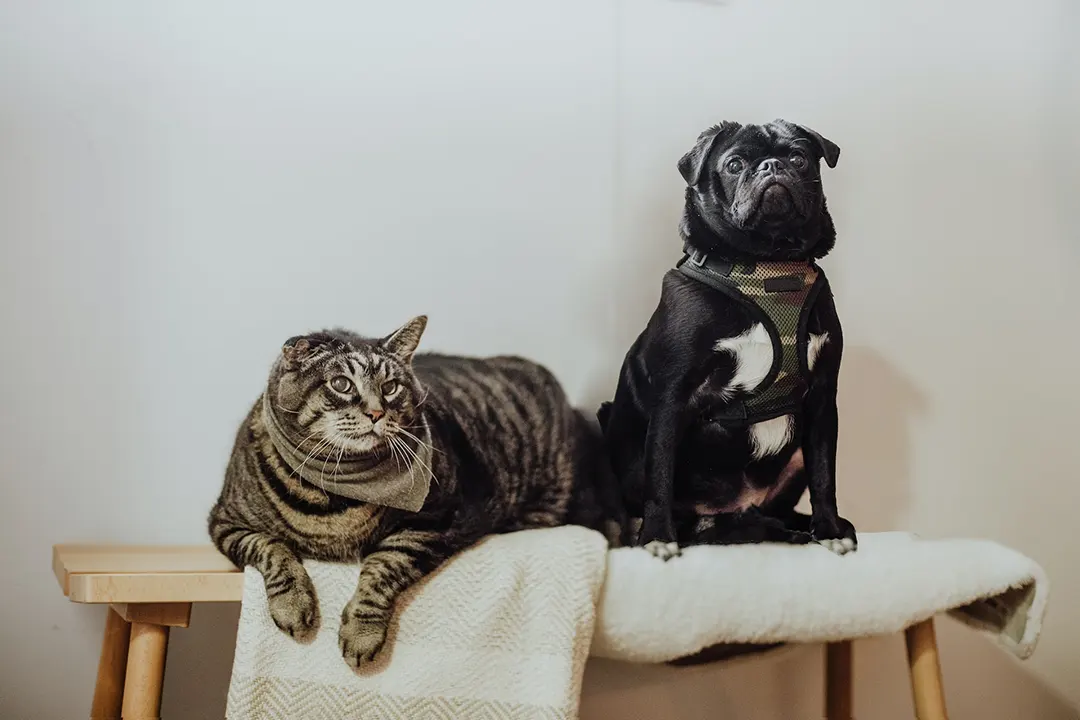Average costs: Dogs vs. cats
One noticeable difference is that dog insurance tends to cost more than cat insurance. Dogs are more costly to insure and can come in at an average of £139 a year, and £75 a year for cats. There are a few reasons dogs cost more to insure:
- Size - Larger dogs incur higher treatment costs
- Activity levels - Active dogs have a higher risk of injury
- Lifespan - Dogs often have shorter lifespans than cats
Of course, factors like breed, age, location and selected coverage will impact premiums for individual pets. But on average, dogs do work out more expensive than cats to insure.
Common conditions covered
When comparing pet insurance policies, you want to ensure common conditions for your particular animal are covered. Some conditions like arthritis are prevalent across both species. Others differ between cats and dogs.
Common dog conditions covered include:
- Arthritis
- Hip dysplasia
- Elbow dysplasia
- Cruciate ligament issues
- Ear infections
- Skin allergies
- Gastric torsion/bloat
Common cat conditions covered are:
- Arthritis
- Urinary tract infections
- Kidney disease
- Hyperthyroidism
- Diabetes
- Skin allergies
- Dental disease
Top UK pet insurers will cover the diagnosis and treatment of breed-specific illnesses without exclusion. Read policy documents carefully and make sure to double-check.
Preventative coverage differences
Most providers now offer some level of cover for routine preventative care like vaccinations, flea/tick/worming treatment and wellness exams. But the costs covered can vary significantly between cat and dog insurance policies.
For example, dog insurance may offer £80 towards annual boosters and checks, whereas cat insurance includes just £50. Dog policies could cover flea and worming products 100%, but cat policies only 50%. Check how much you could claim for preventative care costs each year.
Insurers commonly exclude pre-existing conditions from coverage in all policies. Other typical exclusions like breeding and elective/cosmetic procedures also generally apply equally to cat and dog insurance.
However, some exclusions may be specific to dogs due to increased risks.
For example, dog policies may exclude cover for:
- Tail docking
- Microchipping
- Third-party liability (injury/property damage)
- Commercial use liabilities
Cat policies are more likely to exclude:
- Declawing
- Boarding fees
- Grooming/nail clipping
Pet owners should not consider docking the tails of their dogs, or declawing their cats. It can cause extreme pain and discomfort.
Benefit limits
Both cat and dog policies offer a range of annual benefit limits from £1,000 to £15,000 or unlimited. As treatment costs for dogs tend to be higher, choosing a sufficient limit is critical for adequate cover.
For cats, a lower limit like £7,000 may be enough for most care needs. But dog owners may want to consider a £10,000 limit minimum to avoid falling short. Compare pet insurance quotes with your vet to select appropriate cover levels.
Lifetime cover vs. 12 months
Another key decision is whether to select lifetime or 12-month (annually renewable) cover for your pet. Lifetime policies offer continuous vet fee cover year after year.
For cats, lifetime cover can make financial sense as they often live longer lives. Spreading costs over 15+ years avoids premium hikes as they age.
But for large breed dogs with shorter life expectancies, 12-month policies may be sufficient. Review renewal terms carefully as providers can increase prices annually.
Every pet has unique needs
While dog and cat insurance share many common features, some important differences exist. Dogs typically cost more to insure and require higher benefit limits. Cat insurance comes with lower premiums on average. But individual factors like breed, age and pre-existing conditions impact any pet’s policy pricing.
Work with a knowledgeable pet insurance broker to compare quotes suited to your particular cat or dog’s needs. Look beyond the annual premium to understand cover for breed-specific conditions, exclusions, reimbursement rates and benefit limits. This ensures you select tailored protection so your furry companion receives the very best care.
If you want to get pet insurance for your cat or dog, look through our comparison tables to find a provider ranked by product quality and customer reviews.

